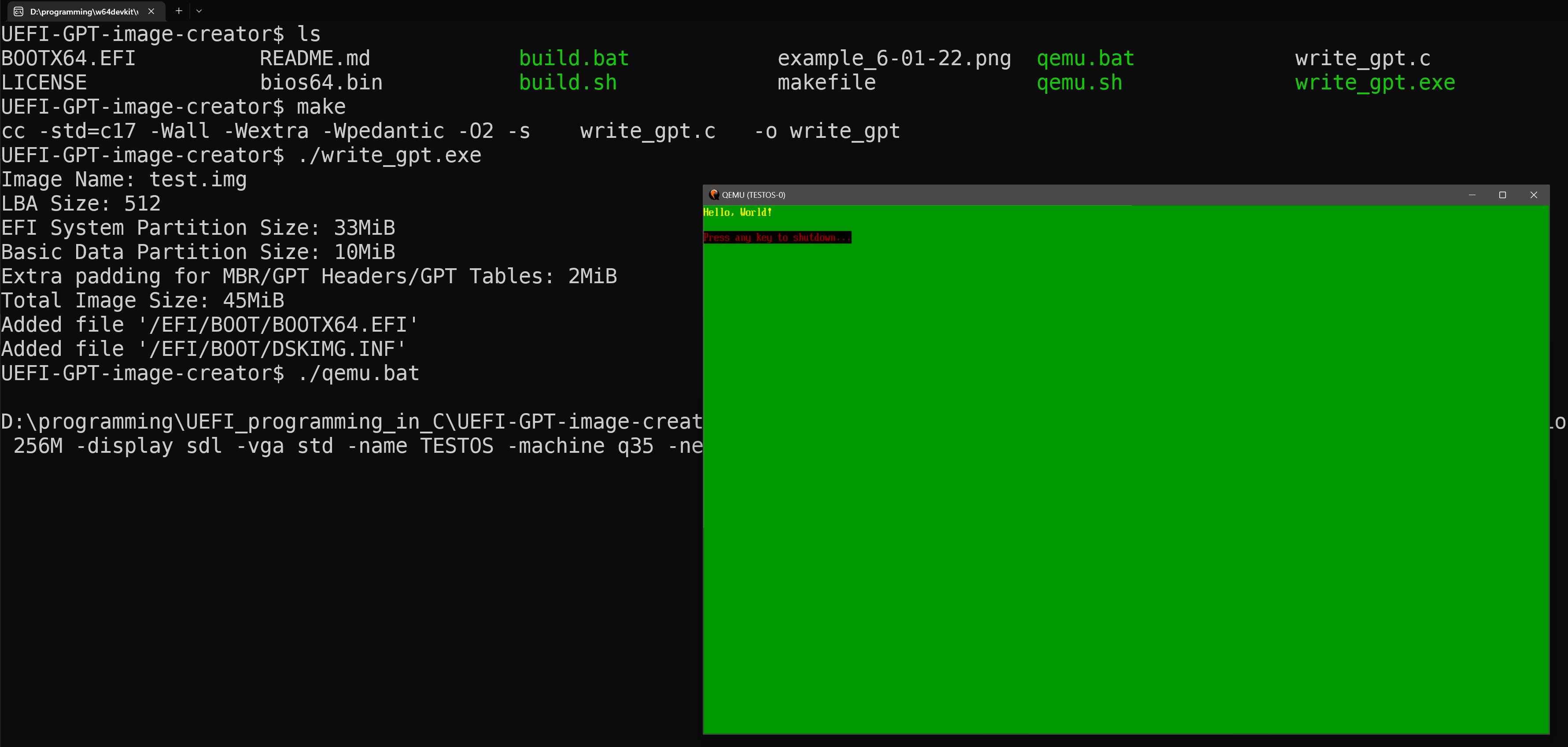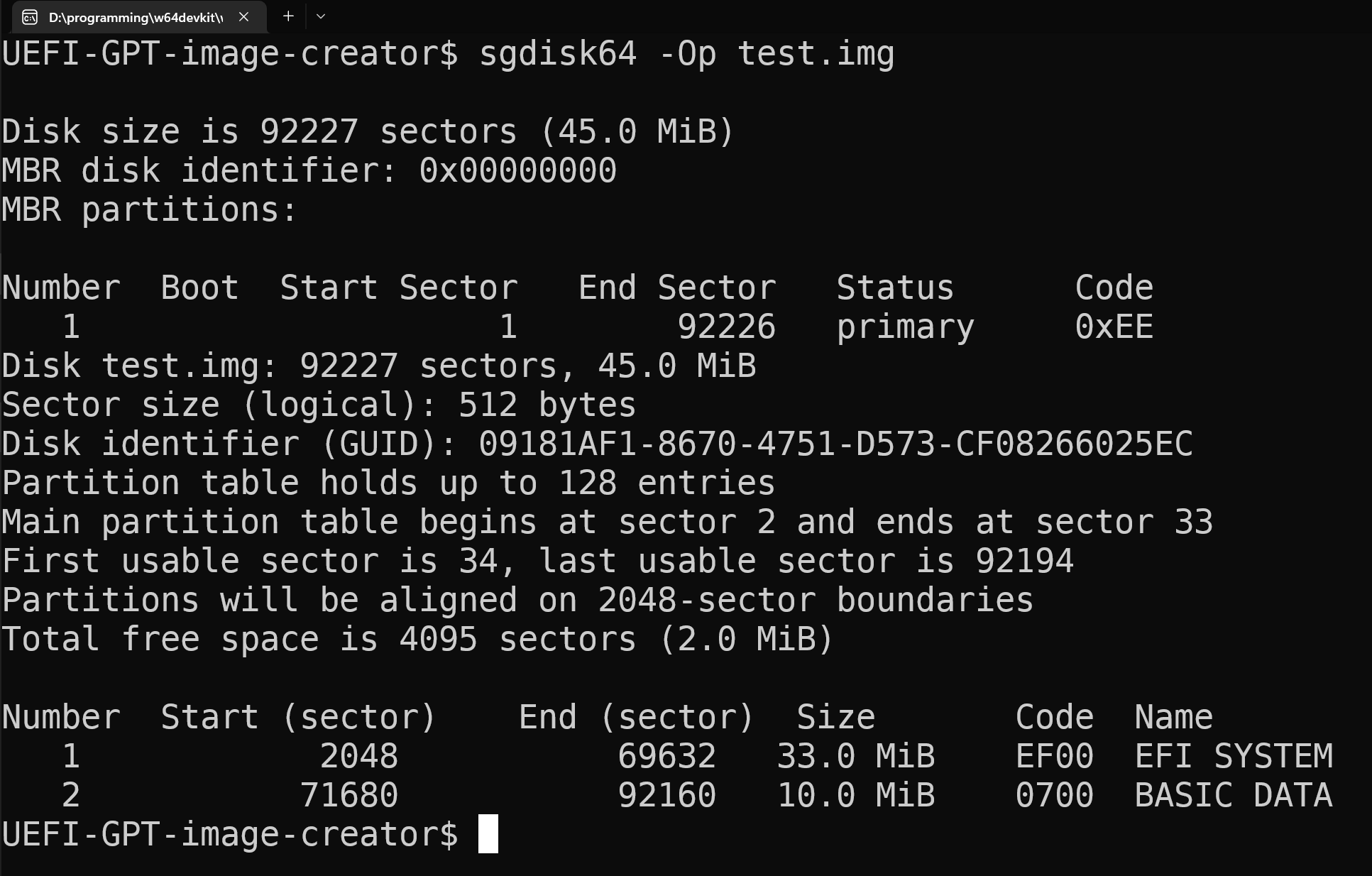GPT Disk Image Creator for UEFI Development, including EFI System Partition (ESP) with FAT32 Filesystem and Basic Data Partition
This is a self-contained C program to build a valid GPT disk image file, with FAT32 filesystem containing /EFI/BOOT/ directories, and optional BOOTX64.EFI file.
Its purpose is to aid in UEFI development, and reduce dependencies on other programs to mount a disk, create a FAT32 filesystem, and move files into an image.
-
Generated disk image files have been tested on both qemu and hardware (Dell XPS13 7390) after writing to a usb drive.
-
Verified GPT status of output images with gdisk/sgdisk (sgdisk64 on windows) and qemu with OVMF.
The generated image contains an EFI System Partition with FAT32 filesystem with a minimum size of ~33MiB for 512 byte sectors, and an empty Basic Data Partition with a default size of 1MiB. The data partition can be used to hold files such as an OS or kernel binary.
The size of both partitions can be changed with command line parameters, see Usage section below.
If the file BOOTX64.EFI is found in the current directory when write_gpt is ran, it will be added to the /EFI/BOOT/ directory in the ESP.
This file is assumed to be an x86_64 EFI Application, and will be booted automatically in QEMU/OVMF or on UEFI compliant hardware.
A FILE.TXT file will be created containing the size of the generated image, and added to the /EFI/BOOT/ directory.
If adding files to the data partition with -ad <files> --add-data-files <files>, a FILE.TXT file will be created in /EFI/BOOT/ in the ESP. It will have info on each file added, including each file's name, size in bytes, and starting lba (disk sector) in the disk image.
The purpose of this is to e.g. find a kernel or other files more easily within an EFI application, but not impose or create any set filesystem.
A valid OVMF file for qemu is included as bios64.bin. Use it with qemu as -bios bios64.bin.
qemu.bat/qemu.sh is included as an example to run the EFI application in the image through emulation; change the drive, bios, and any other parms as needed.
Scripts are provided, assuming packages are installed, to mount and unmount an image file on linux and windows.
Linux should use mnt_image_linux.sh and unmnt_image_linux.sh, which use packages nbd/nbd-client/qemu-nbd.
Windows should use mnt_vhd_windows_powershell.ps1, which uses powershell commands and needs to be run as administrator.
!! Use caution and do not assume any names or volume numbers for partitions, etc. are valid, and run things manually first to ensure you are comfortable running them automatically. You may mess up your disks if you aren't careful. !!
C compiler with support for C17 standard or higher (minor changes will be needed if using a standard older than C17), for UTF-16 u"" string literals and uchar.h header. Tested with gcc, mingw gcc, and clang.
- Windows:
buildormake - Linux/BSD:
./build.shormake
- Windows:
write_gpt.exe - Linux/BSD:
./write_gpt
This will create a new image file with the default name test.hdd.
write_gpt [options]
options:
-ad --add-data-files Add local files to the basic data partition, and create
a <FILE.TXT> file in directory '/EFI/BOOT/' in the
ESP. This INF file will hold info for each file added
ex: '-ad info.txt ../folderA/kernel.bin'.
-ae --add-esp-files Add local files to the generated EFI System Partition.
File paths must start under root '/' and end with a
slash '/', and all dir/file names are limited to FAT 8.3
naming. Each file is added in 2 parts; The 1st arg for
the path, and the 2nd arg for the file to add to that
path. ex: '-ae /EFI/BOOT/ file1.txt' will add the local
file 'file1.txt' to the ESP under the path '/EFI/BOOT/'.
To add multiple files (up to 10), use multiple
<path> <file> args.
ex: '-ae /DIR1/ FILE1.TXT /DIR2/ FILE2.TXT'.
-ds --data-size Set the size of the Basic Data Partition in MiB; Minimum
size is 1 MiB
-es --esp-size Set the size of the EFI System Partition in MiB
-h --help Print this help text
-i --image-name Set the image name. Default name is 'test.hdd'
-l --lba-size Set the lba (sector) size in bytes; This is
experimental, as tools are lacking for proper testing.
Valid sizes: 512/1024/2048/4096
-v --vhd Create a fixed vhd footer and add it to the end of the
disk image. The image name will have a .vhd suffix.-ae/--add-esp-files and -ad/--add-data-files will add files to a new image file each time. They do not update an existing image.

